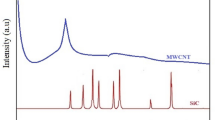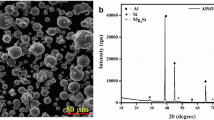Abstract
Interfacial Al-Ce-Cu-W amorphous layers formed through thermally driven solid-state amorphization within the (W+CeO2)/2024Al composite were investigated. The elemental distributions and interfacial microstructures were examined with an electron probe microanalyzer and a high-resolution transmission electron microscope, respectively. The consolidation of composites consisted of two thermal processes: vacuum degassing (VD) and hot isostatic pressing (HIP). During consolidation, not only the three major elements (Al, W, and Ce) but also the alloying elements (Mg and Cu) in the Al matrix contributed to amorphization. At VD and HIP temperatures of 723 K and 763 K, interfacial amorphous layers were formed within the composite. Three diffusion processes were necessary for interfacial amorphization: (a) long-range diffusion of Mg from the Al matrix to the interfaces during VD; (b) long-range diffusion of Cu from the Al matrix to the interfaces during HIP; (c) short-range diffusion of W toward the Al matrix during HIP. The newly formed interfacial Al-Ce-Cu-W amorphous layers can be categorized under the Al-Ce-TM (TM: transition metals) amorphous system.
Similar content being viewed by others
References
M.H. Cohen and D. Turnbull, Composition requirements for glass formation in metallic and ionic systems, Nature, 189(1961), No. 4759, p. 131.
R.B. Schwarz and W.L. Johnson, Formation of an amorphous alloy by solid-state reaction of the pure polycrystalline metals, Phys. Rev. Lett., 51(1983), No. 5, p. 415.
R.B. Schwarz, K.L. Wong, W.L. Johnson, and B.M. Clemens, A study of amorphous alloys of Au with group III A elements (Y and La) formed by solid-state diffusion reaction, J. Non-Cryst. Solids, 61–62(1984), p. 129.
E.J. Cotts, W.J. Meng, and W.L. Johnson, Calorimetric study of amorphization in planar, binary, multilayer, thin-film diffusion couples of Ni and Zr, Phys. Rev. Lett., 57(1986), No. 18, p. 2295.
S.B. Newcomb and K.N. Tu, Transmission electron microscopic observations of amorphous NiZr alloy formation by solid-state reaction, Appl. Phys. Lett., 48(1986), No. 21, p. 1436.
R.J. Highmore, J.E. Evetts, A.L. Greer, and R.E. Somekh, Differential scanning calorimetry study of solid-state amorphization in multilayer thin-film Ni/Zr, Appl. Phys. Lett., 50(1987), No. 10, p. 566.
K.N. Tu, G.V. Chandrashekhar, and T.C. Chou, Amorphous alloy formation by solid state reaction, Thin Solid Films, 163(1988), p. 43.
G.V. Chandrashekhar, D. Gupta, S. Newcomb, F.H.M. Spit, and K.N. Tu, Comparison between amorphous Ni-Zr alloys formed by solid state reaction and by codeposition, Thin Solid Films, 164(1988), p. 199.
M. Van Rossum, M-A. Nicolet, and W.L. Johnson, Amorphization of Hf-Ni films by solid-state reaction, Phys. Rev. B, 29(1984), No. 10, p. 5498.
P. Guilmin, P. Guyot, and G. Marchal, Amorphization of crystalline Co and Sn multilayers by solid state reaction, Phys. Lett. A, 109(1985), No. 4, p. 174.
H. Schröder, K. Samwer, and U. Köster, Micromechanism for metallic-glass formation by solid-state reactions, Phys. Rev. Lett., 54(1985), No. 3, p. 197.
Z.H. Yan and W.K. Wang, Amorphous Fe-Ti alloy formed by solid state reaction, Solid State Commun., 68(1988), No. 9, p. 811.
D.A. Lilienfeld, M. Nastasi, H.H. Johnson, D.G. Ast, and J.W. Mayer, Amorphous-to-quasicrystalline transformation in the solid state, Phys. Rev. Lett., 55(1985), No. 15, p. 1587.
I. Levi and D. Shechtman, Amorphous and quasicrystalline Al-Cr and Al-Cr-Si phases produced by solid state diffusion of alternating thin layers, [in] J.C. Toledano, ed., Geometry and Thermodynamics, NATO ASI Series (Series B: Physics), Vol. 229, Springer, Boston, MA, 1990, p. 371.
P.L. Ratnaparkhi and J.M. Howe, Amorphous phase formation by solid state reaction at a diffusion-bonded Al/SiC interface, Scripta Metall. Mater., 27(1992), No. 2, p. 133.
B.X. Liu, J.R. Ding, D.Z. Che, and H.B. Zhang, Al-Yb amorphous alloys produced by ion mixing or solid state reaction, [in] G.S. Was, L.E. Rehn, and D.M. Follstaedt, eds., Phase Formation and Modification by Beam-Solid Interactions Symposium, Boston, MA, 1991, p. 521.
U. Gösele and K.N. Tu, “Critical thickness” of amorphous phase formation in binary diffusion couples, J. Appl. Phys., 66(1989), No. 6, p. 2619.
A. Inoue, K. Ohtera, A.P. Tsai, and T. Masumoto, Aluminum-based amorphous alloys with tensile strength above 980 MPa (100 kg/mm2), Jpn. J. Appl. Phys., 27(1988), No. 4, p. L479.
Y. He, S.J. Poon, and G.J. Shiflet, Synthesis and properties of metallic glasses that contain aluminum, Science, 241(1988), No. 4873, p. 1640.
Y. Shen and J.H. Perepezko, Al-based amorphous alloys: Glass-forming ability, crystallization behavior and effects of minor alloying additions, J. Alloys Compd., 707(2017), p. 3.
X.F. Wang, D. Wang, B. Zhu, Y.J. Li, and F.S. Han, Crystallization kinetics and thermal stability of mechanically alloyed Al76Ni8Ti8Zr4Y4 glassy powder, J. Non-Cryst. Solids, 385(2014), p. 111.
G. Wilde, H. Sieber, and J.H. Perepezko, Glass formation versus nanocrystallization in an Al92Sm8 alloy, Scripta Mater., 40(1999), No. 7, p. 779.
Z. Lv, C.H. Mao, J. Wang, Q.S. Liang, S.W. Ma, Z.M. Yang, J. Yang, and Y. Li, Interfacial microstructure in W/2024Al composite and inhibition of W-Al direct reaction by CeO2 doping: Formation and crystallization of Al-Ce-Cu-W amorphous layers, Materials, 12(2019), No. 7, p. 1117.
M. Matsuura, M. Sakurai, K. Suzuki, A.P. Tsai, and A. Inoue, Local structure change of Ce and Cu in the course of nanocrystalline formation from amorphous Al87Ni8Ce3Cu2, Mater. Sci. Eng. A, 226–228(1997), p. 511.
C.Triveño Rios, S. Suriñach, M.D. Baró, C. Bolfarini, W.J. Botta, and C.S. Kiminami, Glass forming ability of the Al-Ce-Ni system, J. Non-Cryst. Solids, 354(2008), No. 42–44, p. 4874.
H. Yang, J.Q. Wang, and Y. Li, Influence of TM and RE elements on glass formation of the ternary Al-TM-RE systems, J. Non-Cryst. Solids, 354(2008), No. 29, p. 3473.
K.K. Song, X.F. Bian, X.Q. Lv, J. Guo, G.H. Li, and M.T. Xie, Compositional dependence of glass-forming ability, mediumrange order, thermal stability and liquid fragility of Al-Ni-Ce-based amorphous alloys, Mater. Sci. Eng. A, 506(2009), No. 1–2, p. 87.
G.H. Li, W.M. Wang, X.F. Bian, J.T. Zhang, R. Li, and L. Wang, Comparing the dynamic and thermodynamic behaviors of Al86Ni9-La5/(La0.5Ce0.5)5 amorphous alloys, J. Alloys Compd, 478(2009), No. 1–2, p. 745.
S.P. Sun, D.Q. Yi, H.Q. Liu, B. Zang, and Y. Jiang, Calculation of glass forming ranges in Al-Ni-RE (Ce, La, Y) ternary alloys and their sub-binaries based on Miedema’s model, J. Alloys Compd., 506(2010), No. 1, p. 377.
J.J. Luo, G.Y. Wang, H.R. Qi, Y. Yokoyama, P.K. Liaw, and A. Inoue, Interpreting temperature evolution of a bulk-metallic glass during cyclic loading through spatial-temporal modeling, Intermetallics, 29(2012), p. 1.
X.F. Hu, J. Guo, G.J. Fan, and T.T. Feng, Evaluation of glass-forming ability for Al-based amorphous alloys based on superheated liquid fragility and thermodynamics, J. Alloys Compd., 574(2013), p. 18.
C.L. Li, J.W. Murray, K.T. Voisey, A.T. Clare, and D.G. McCartney, Amorphous layer formation in Al860Co76Ce64 glass-forming alloy by large-area electron beam irradiation, Appl. Surf. Sci., 280(2013), p. 431.
C. Lea and C. Molinari, Magnesium diffusion, surface segregation and oxidation in Al-Mg alloys, J. Mater. Sci., 19(1984), p. 2336.
D.T.L. van Agterveld, G. Palasantzas, and J.Th.M. De Hosson, Magnesium surface segregation and oxidation in Al-Mg alloys studied with local probe scanning Auger-scanning electron microscopy, Appl. Surf. Sci., 152(1999), No. 3–4, p. 250.
W.D. Xiao, Q.L. Guo, and E.G. Wang, Transformation of CeO2(111) to Ce2O3(0001) films, Chem. Phys. Lett., 368(2003), No. 5–6, p. 527.
J.M. Chen, X.M. Zhang, Y.L. Deng, Y. Xiao, C. Xiong, and H. Jiang, Thermodynamics of melding and refining of magnesium alloys, J. Cent. South Univ.: Sci. Technol., 37(2006), No. 3, p. 427.
C.H. Mao, X.D. Sun, Q.S. Liang, J. Yang, and J. Du, Interfacial reaction process of the hot-pressed WC/2024Al composite, Rare Met., 32(2013), No. 4, p. 397.
W.L. Johnson, Thermodynamic and kinetic aspects of the crystal to glass transformation in metallic materials, Prog. Mater. Sci., 30(1986), No. 2, p. 81.
B. Zhang, D.Q. Zhao, M.X. Pan, R.J. Wang, and W.H. Wang, Formation of cerium-based bulk metallic glasses, Acta Mater., 54(2006), No. 11, p. 3025.
D.B. Miracle, W.S. Sanders, and O.N. Senkov, The influence of efficient atomic packing on the constitution of metallic glasses, Philos. Mag., 83(2003), No. 20, p. 2409.
D.B. Miracle, The efficient cluster packing model — An atomic structural model for metallic glasses, Acta Mater., 54(2006), No. 16, p. 4317.
Author information
Authors and Affiliations
Corresponding author
Rights and permissions
About this article
Cite this article
Lü, Z., Mao, Ch., Wang, J. et al. Formation of interfacial Al-Ce-Cu-W amorphous layers in aluminum matrix composite through thermally driven solid-state amorphization. Int J Miner Metall Mater 27, 970–979 (2020). https://doi.org/10.1007/s12613-019-1952-0
Received:
Revised:
Accepted:
Published:
Issue Date:
DOI: https://doi.org/10.1007/s12613-019-1952-0




